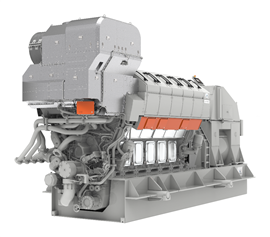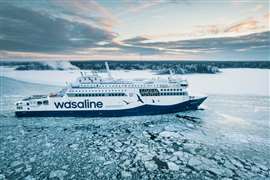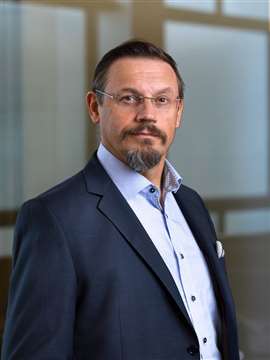Wärtsilä marine engine cuts methane emissions 41%, sets stage for the future
02 November 2023
Technology group Wärtsilä continues to develop solutions intended to substantially reduce harmful emissions from marine engines and further its customers’ decarbonization efforts. Its latest announcement centers around the introduction of an ultra-low emission version of its 31DF medium-speed four-stroke model.
 The ultra-low emission 31DF can reduce methane emissions by 41% compared to the standard engine. (Photo: Wärtsilä)
The ultra-low emission 31DF can reduce methane emissions by 41% compared to the standard engine. (Photo: Wärtsilä)
The 31DF comes in cylinder configurations from 8 to 16 and with a power output from 4.6 to 10.4 MW at 720 and 750 rpm. Available in diesel, dual-fuel and pure gas versions, the standard engine is reported to have the lowest emissions levels on the market.
The new ultra-low emission dual-fuel (diesel/gas) version has been shown to further reduce methane emissions on a 50% load point by up to 56% when operating on LNG and nitrogen oxide (NOx) by up to 86%. On a weighted average, it can reduce methane emissions by 41% compared to the standard engine, Wärtsilä stated.
Minor modifications bring big change
The ultra-low emissions 31DF retains the two-stage turbocharging, variable valve timing, common rail fuel system, fully electronic control and pilot fuel injection (gas mode) of the original 31DF dual-fuel configuration.
“In order to manage an efficient combustion within the cylinder, we need to carefully control both the air exhaust and the fuel flows. That two-stage turbocharging gives us… a lot of air in the cylinders if and when possible,” said Juha Kytölä, Wärtsilä’s director of R&D and Engineering. “The valve timing gives us the possibility then to control how much air we finally let into the cylinder at which stage. The high pressure tolerance of the engine allows very high combustion pressures.
“What we have done now is we have utilized fully the opportunity these technologies give us. We have very stable and even combustion in the cylinder so that all the fuel is evenly consumed without adding any high spots, or temperature peaks, in the cylinder.” This result in near-complete fuel combustion and ultra-low NOx emissions.
To achieve such complete fuel burn, modifications were made to the combustion chamber. “To get the lowest methane emissions, that shape within the combustion chamber needs to be optimized so that there are no corners or cavities where any part of the fuel can escape or remain unburned,” Kytölä explained. “It needs to be perfectly shaped and also the combustion concentrated so that it takes place in a stable manner.
“There are modifications,” he acknowledged. “But in respect to the whole engine, those are minor on some components and on the automation side, which make it possible to achieve [50% methane emission reduction].”
 Wärtsilä partnered with Wasaline to pilot the ultra-low emissions concept onboard the Aurora Botnia ferry. (Photo: Wärtsilä)
Wärtsilä partnered with Wasaline to pilot the ultra-low emissions concept onboard the Aurora Botnia ferry. (Photo: Wärtsilä)
Floating lab
To validate the engine’s design, Wärtsilä partnered with Wasaline, a ferry operator transporting passengers and freight between Sweden and Finland. One of the four engines on board Wasaline’s Aurora Botnia ferry was replaced with the ultra-low emissions 31DF to act as a “floating lab concept” to capture real-world data in a working environment.
Wärtsilä piloted the ultra-low emissions concept onboard the Aurora Botnia, an already environmentally friendly RoPax ferry, with results verified through an independent study conducted in December 2022 by VTT, the Technical Research Centre of Finland. The study showed the engine has helped Wasaline to further reduce the Aurora Botnia’s methane emissions by 10%.
“We are very committed to decarbonization, and we have worked closely with Wärtsilä to make sustainable shipping a reality. It is a goal-oriented partnership that benefits both companies, as well as the industry as a whole,” said Peter Ståhlberg, nanaging director of Wasaline. “We have been pleased to allow the Aurora Botnia to be utilized as a floating laboratory, and we are excited to see the success of this latest Wärtsilä technology breakthrough.”
Wärtsilä pointed out that the standard 31DF engine platform already meets current regulatory requirements. The new version will enable operators to go even further in reducing methane emissions, helping to future proof their vessels longer term against potentially tightening global requirements, the company said.
What’s more, improving dual fuel technology to enable methane emissions reduction will have a major impact on the long-term viability of LNG as a marine fuel. “For any of these future fuels, it’s very important to focus on high efficiency. We know that many new fuels that are oncoming – which Wartsila is also working with – very likely will not compete on price with the older fossil fuels; they will be more expensive,” Kytölä acknowledged. “The better efficiency you have, the less fuel you consume and therefore you are not impacted as hard by the cost of the fuel. LNG is a very good transition fuel for getting further from fossil liquid fuels.”
Encouraged by the positive results, Wärtsilä has launched the new ultra-low emissions version of the Wärtsilä 31DF engine to the commercial market. In addition, existing 31DF engines can be modified to the ultra-low emission version.
 Juha Kytölä (Photo: Wärtsilä)
Juha Kytölä (Photo: Wärtsilä)
Future development
Looking beyond LNG, Kytölä said the same engine technology used in the ultra-low emission 31DF can also be applied for other fuels, like methanol.
“Wartsila already has introduced some engines offering close to the similar power range, and the 31 would be an even higher power product, if and when the market is calling for this,” he noted. “Also, Wärtsilä is working a lot with ammonia as a fuel in some markets. In marine. we see ammonia to be an attractive fuel. So, we are studying that in our research, and we are promised that within this year, we would come out with one product on the market.”
The technology could be applied to hydrogen, as well, but onboard space constraints make hydrogen less attractive in a marine environment. “Storing hydrogen in a ship is a challenge because hydrogen takes rather more space – close to eight times more space than diesel fuel to store it. But Wärtsilä is also in the land-based market, [where] we see a lot of interest for hydrogen for powering power stations, so we are also working with that,” Kytölä said.
“The 31 engine is a highly modular engine. The modular concept means that certain functions of the engine are clustered so that it’s easy to modify, for example, for different fuels or for different technology like this.”
The ultra-low emission technology could also be applied to different engine size classes. “[The parameters] we have available from the 31, we also have on the sister engines - the smaller and the bigger one - and now we are of course monitoring the market interest for this technology,” said Kytölä. “Based on the interest, then we will make conclusions if we will also develop a similar concept for these other engines.”
STAY CONNECTED




Receive the information you need when you need it through our world-leading magazines, newsletters and daily briefings.
POWER SOURCING GUIDE
The trusted reference and buyer’s guide for 83 years
The original “desktop search engine,” guiding nearly 10,000 users in more than 90 countries it is the primary reference for specifications and details on all the components that go into engine systems.
Visit Now
CONNECT WITH THE TEAM










